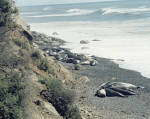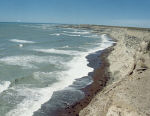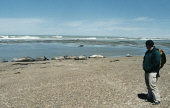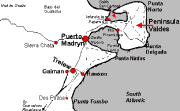
Sitting one day in a dusty Patagonian bus station and not having that much to do we stabbed our finger at a map of Argentina and took the next bus to the town of Puerto Madryn on the Peninsula Valdes, where we were reliably informed by the local tourist office that, “Impressive sea elephants, penguins, whales and seals spend certain seasons on the rough coasts of Patagonia. A unique spectacle and an amazing display of marine life will fascinate the visitor. You will not find anything like this anywhere in the world.”
Now who couldn’t resist that?
History
Puerto Madryn (pop 50,000) is a port on the Golfo Nuevo and was the site of the first Welsh landing in 1865 by 153 Welsh immigrants. Quite what the Welsh were doing there is a bit of a mystery and is some how linked with religious freedom, their xenophobic love of their tricky language and a nasty incident involving Jones the farmer and a sheep.
Geography
This city is a part of the coast corridor formed also by the cities of Trelew, Gaiman, Rawson and West San Antonio. The entire region is characterized by the long beaches and its big marine fauna. Click on the map for a better view in a new browser window.
Where to See Animals
At Punta Norte there are elephant seals (breeding season late Sep/early Oct); at Caleta Valdes, 27 miles south of Punta Norte, you can see Magellan penguins (Oct-Nov nesting), sea lions (Dec-Jan breeding season) and elephant seals.
At Punta Delgada the beach provides excellent viewing of elephant seals and the austere but functional Hotel Faro Punta Delgada provides an overnight spot allowing plenty of time for wildlife viewing – nice bar as well… In addition, guanacos, rheas, armadillos and other wildlife can be seen on the peninsula; wildlife viewing is at its best during October-November.
The big attraction is the southern right whale (Eubalaena australis), which frequent the shallow waters of Golfo Nuevo and Golfo San Carlos between June and mid-December to breed and bear their young; Puerto Piramdes is the departure point for whale viewing excursions. I really hope to go back one day to see the whales and their calves – it must be an incredible sight.
Located to 107 km to the south of Trelew, Tombo Point Reserve is one of the most beautiful examples of fauna in the world. It is only comparable with the Galapagos. There is no other colony of penguins of this magnitude that is so easy to reach anywhere in the world. In season there can be close to a million penguins there.
Getting There
Most people tend to arrive by bus. Due to its geographical location, Puerto Madryn is an excellent stopping off place for people on route from El Calafate or Rio Gallegos to Buenos Aires. Bus travel in Argentina is reasonably expensive but, considering the fantastic distances covered, it’s a good way to travel. The 24 hour trip from Rio Gallegos to Puerto Madryn is an interesting route popular with travellers. From my diary:
‘…sitting eating cakes on the back of the bus looking out at a monotonous landscape of flat, flat fields of nothingness…dry dusty stony roads…our bus throws up dust devils which stretch away for miles behind us. We are the only thing moving under the impossibly larger sky, it seems that all the world’s excess sky is up for grabs in Argentinean Patagonia.’
And after a month of travelling in Patagonia:
‘I bloody hate pampas.’
There is also an airport in Puerto Madryn but for some unknown reason it’s not generally used. Most flights stop at Trelew some 65 km away. From my diary on Trelew:
‘…on the outskirts of Trelew are gathered a grim collection of foreboding brick houses. It’s a grim industrial looking town and I am glad we are rolling onwards and not stopping here.’
The local tourist agency was more forthcoming about Trelew, “Do not be surprised if on highway 25, near Trelew city, you come across chapels and other buildings which appear to be Welsh. Immigrants from last century built them. You can also have tea and traditional cookies in teahouses, at 5 o’clock on the dot!”
Accommodation
I stayed at the excellent Residencial Vaskonia (72581) which at US$24 for a double room per night has to be one of the travel bargains of Argentina. From my diary again:
‘…the hotel is magnificently clean and our spacious room has a double and a single bed. The rooms are built around a pleasant white washed courtyard which seems to suck up the sounds of the busy road outside. The owner has just taken great pains to try to explain something to use. It was obviously extremely important as she spent twenty minutes speaking painfully slow Spanish and wringing her hands a lot. We came to the conclusion that she is mad and let her have her fun.’
The hotel seemed to be a popular place with travellers but you should be able to turn up and get a room. It’s conveniently located a few blocks from the bus station and a few blocks from the main street. It’s opposite a good supermarket and call centre which has an internet connection.
Places to Eat
Although there are many tourist bars and restaurants many of them were very expensive – a meal for two people with wine was about US$20-25 and so we tended to stick to the bars and pizza restaurants in the general vicinity of our hotel.
Things to Do

Although railway enthusiasts may find the rusted steam engine outside the bus terminal a source of indescribable joy, most people come to Puerto Madryn to visit the Peninsula Valdes and see its impressive collection of wildlife. There are about a million and one tour agencies in town and although it’s worth shopping around a bit they all offer more or less the same trip and this hardly ever includes an English-speaking guide.
The tourist office is reasonably helpful when it comes to handing out phone numbers and maps but they remain rather non-committal when it comes to recommending particular agencies. However, their visitor’s book is a mine of information and has lots of valuable, and hard earned, local knowledge from previous travellers. We settled on a tour with a Spanish speaking guide for US$25 (this seemed to be the going rate) which included all transfers and visited all the important sites.
Normally I hate tours and only take one when it is absolutely essential. I had planned to hire a car and drive out to the Peninsula but when I found out that car hire starts at about US$100 a day and that the roads are bad enough so that you can expect to damage the car in some way I decided that even I could tolerate being with a bunch of sappy tourists for a day.
The next day our small minivan picked us up at 7:30am and we made a quick circuit to pick up the other punters – a group of macho Spanish middle age men, a couple of middle aged Italian ladies and a sprinkling of Argentineans down from the big smoke of Buenos Aires for a couple of days.
Our guide spoke terrible guttural Spanish, which was difficult for me to understand, but we had to feel sorry for her as she was obviously having a seriously bad hair day and had quite clearly got dressed in the dark (yellow canvas shoes, tattered combat trousers rolled up to her knees and a white vest). She made no real effort to speak slower for us which was probably just as well as she seemed to adopt a school mistress attitude to the other punters and spent the day tapping her watch and trying to get people to leave early. My girlfriend and I purposefully ignored her and pretended not to speak anything apart from Dutch. The moral of this little story is that if entirely possible try to meet the guide in advance. From my diary:
‘…the guide is standing at the front of the bus rolling her r’s threateningly and trying to flirt with the group of macho Spanish guys. She makes the beautiful Spanish language sound coarse and bitter. She is at odds with the beautiful landscape which is unfolding outside of the bus’.
The first stop on most of the tours is the museum at the entrance to the park of which the local tourist agency had told me “We recommend that you visit first the Interpretation Centre at the Ameghino isthmus in Valdés Península where you will be given you all the information you need.” From my diary:
‘…there is a futile looking observation tower which smells of piss and a dusty museum…a random collection of old shells, driftwood and sun bleached bones. I follow a British couple round the museum. The woman is clearly as depressed and confused as I am. Exasperated she turns to her husband and in a loud upper class British voice tells him “I haven’t got the faintest clue what this all about.” I fall out into the sun laughing – the guide wags her finger at me – having fun is apparently only allowed on the other tour.’

The second stop was on the top of a wind-swept cliff to see a colony of elephant seals which were basking in the sun. From my diary:
‘At this time of year there are only mothers and young pups present, but as they can weigh up to 4 tonnes they are quite impressive.
They don’t really have much charm or personality and seem to spend most of their time lying in the sun, but there is something impressive about them. Occasionally they fart loudly which causes our group to dissolve into fits of giggles whilst our guide looks on sternly.’
I would have been content to spend the rest of the day there but we were only allowed a short stop for photographs. The agency had told me this would be the case but still it would have been nicer to have more time.

However, all my bad feelings about the trip and the guide soon dissolved at our next stop. We parked at the lighthouse and then climbed down a dangerous looking track onto a stretch of deserted beach which was thick with basking elephant seals. The guide led us to within a few meters of the main herd and instructed us to sit down and not to speak. She warned that the seals were happy to be observed but were aggressive when provoked and that that under no circumstances should we provoke the seals (such as by wearing lemon coloured deck shoes and rolled up combat pants).
Everyone slowly drifted into their own thoughts and was soon absorbed in watching the animals making their leisurely way to the sea, jostling for the best position on the shore and occasionally lifting their bottoms high in the air and farting loudly. It was, for me, a magical experience and as people drifted off to lunch at the lighthouse I found myself alone on a beach with a couple of hundred elephant seals and my girlfriend. “It must feel like a family reunion for you,” she muttered as I snapped away with my camera.
In the afternoon there was the possibility of taking a boat trip. At certain times of the year whales are seen off the coast and from the impressive photographs in the agent’s office you can approach them closely. The boat trip, which lasts a few hours, costs about US$30.
I decided not to take the trip as whale season had finished. The people who came back from the trip complained that not only did they not see a single animal on their trip but also the tide was at low level and they couldn’t even get close to the sea lion colony. It would have been better to take the boat trip in the morning and visit the other sites in the afternoon. This kind of detail can be arranged with the tour agency beforehand.
About the Author

The author has traveled to about 50 countries and lived in places as diverse as Brazil and Japan. When not travelling he can be found writing sarcastic letters to Air Portugal or with his head in a map whilst nursing a pint in his local Cambridge pub. Travelling or not, he can be contacted at: nihon_news@yahoo.com
